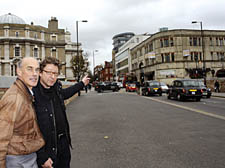|
|
 |
| |

Retired conservation officer Alec Foreshaw and councillor Martin Klute at the Turnmill building |
Key ‘gateway’ building saved from bulldozers
Heritage expert comes out of retirement to oppose demolition
A FORMER nightclub hailed as part of the “gateway to Clerkenwell” has been rescued from demolition.
Ex-conservation officer Alec Foreshaw felt so strongly about the proposed destruction of the 123-year-old Turnmill building in Clerkenwell Road that he came out of retirement to oppose the plans at the council’s south area planning committee last week.
Property firm Derwent London has been sent back to the drawing board after failing to convince planners that the building was unmarketable and would have to be flattened.
It wants to replace the Turnmill building with a seven-storey glass office block. But the company faced objections from residents and conservation groups Save Britain’s Heritage, English Heritage and The Victorian Society.
Mr Foreshaw, a conservation officer for 20 years, said the loss of the building, which houses a restaurant and offices, would destroy the gateway to Clerkenwell formed by Turnmill and the Sessions House across the road.
He felt he had to object in person at last week’s meeting after learning that the council’s planning officers had recommended approving the application.
Mr Foreshaw said: “I’ve generally taken a back seat since I’ve retired. But on this particular cause, this is a building I’ve been much involved with. I felt the panel was being poorly advised. I’m mystified why they recommended approval when the grounds for rejection were so strong.”
He said Derwent was told four years ago the council’s planning department would not agree to demolition but that it returned to try its luck now that Mr Foreshaw and the former planning director had left.
He added: “I remember thinking at the time they should use the building. There’s nothing wrong with it. The grounds for refusal are rock solid. It’s a pivotal building in that whole panorama of Clerkenwell. As a piece of architecture it’s not spectacular but it’s very nicely put together. It’s got a very elegant curve. What was proposed to replace it was enormous.”
Derwent argued that keeping the building was not financially viable because it was struggling to let the space. According to Islington’s planning policies, a property owner must prove it is unable to find a suitable buyer for a building in a conservation area before applying for permission to demolish it.
Councillors were not convinced Derwent had tried hard enough to find a buyer. Labour councillor Martin Klute said: “They don’t know if it can be sold until they physically market it. They were trying to wriggle out of seeing if anyone was willing to buy it and use it without knocking it down.
“It’s an important building, it’s very characterful.
“This is a classic example of the owner of a building deliberately running it down and using this as an excuse to get rid of it. I’m amazed they thought we’d believe it.”
Derwent declined to comment. The firm already has permission for a rooftop extension set back from the building’s frontage. |
 |
|
|
 |
| |
| |
|
 |
|